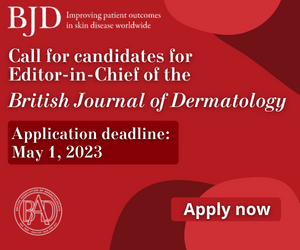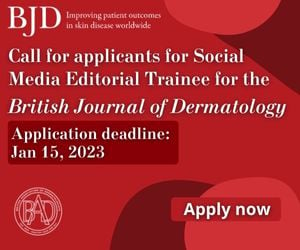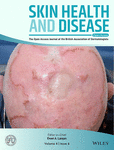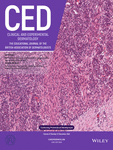Journal list menu
Export Citations
Download PDFs
Editor's Choice
EDITORIALS
Patient-centred health care for people with chronic skin conditions
- Pages: 329-330
- First Published: 18 August 2017
Keratinocyte skin cancers in the spotlight
- Pages: 334-335
- First Published: 18 August 2017
COMMENTARIES
Psoralen–ultraviolet A maintenance in mycosis fungoides: the underlying question
- Pages: 336-337
- First Published: 18 August 2017
Linked Article: Grandi et al. Br J Dermatol 2017; 177:406–410.
Maintenance therapy with psoralen–ultraviolet A for mycosis fungoides: in the absence of evidence sitting on the fence is appropriate
- Pages: 337-338
- First Published: 18 August 2017
Linked Article: Grandi et al. Br J Dermatol 2017; 177:406–410.
Switching expensive drugs with frequently diminishing value
- Pages: 338-339
- First Published: 18 August 2017
Linked Article: Bagel et al. Br J Dermatol 2017; 177:411–418.
Ustekinumab for severe atopic dermatitis: an important negative study
- Pages: 339-341
- First Published: 18 August 2017
Linked Article: Saeki et al. Br J Dermatol 2017; 177:419–427.
The role of access to care in acral lentiginous melanoma survival
- Pages: 341-342
- First Published: 18 August 2017
Linked Article: Asgari et al. Br J Dermatol 2017; 177:428–435.
Expanding mutation landscape and phenotypic spectrum of autosomal recessive congenital ichthyosis
- Pages: 342-343
- First Published: 18 August 2017
Linked Article: Zimmer et al. Br J Dermatol 2017; 177:445–455.
HSP90 inhibition in angiosarcoma
- Pages: 343-344
- First Published: 18 August 2017
Linked Article: Yamada-Kanazawa et al. Br J Dermatol 2017; 177:456–469.
Genetic prediction of treatment response in psoriasis is still a work in progress
- Pages: 344-345
- First Published: 18 August 2017
Linked Article: Talamonti et al. Br J Dermatol 2017; 177:489–496.
Drug survival of methotrexate in psoriasis
- Pages: 345-346
- First Published: 18 August 2017
Linked Article: Otero et al. Br J Dermatol 2017; 177:497–504.
Fatigue and psoriasis
- Pages: 346-347
- First Published: 18 August 2017
Linked Article: Skoie et al. Br J Dermatol 2017; 177:505–512.
Lifting the biofilm lid on the antibacterial and antibiofilm effects of sodium hypochlorite against Staphylococcus aureus in atopic dermatitis
- Pages: 347-348
- First Published: 18 August 2017
Linked Article: Eriksson et al. Br J Dermatol 2017; 177:513–521.
Alopecia in Cronkhite–Canada syndrome
- Pages: 348-349
- First Published: 18 August 2017
Linked Article: Ong et al. Br J Dermatology 2017; 177:531–534.
Reviews
SCHOLARLY REVIEWS
Current perspective on actinic keratosis: a review
- Pages: 350-358
- First Published: 08 August 2016
What's already known about this topic?
- Actinic keratoses (AKs) are a major public health concern because of their high prevalence, substantial cost and potential for progression to keratinocyte carcinoma, particularly squamous cell carcinoma.
What does this study add?
- Improved agreement among healthcare practitioners on AK definition and classification is needed to improve management.
- More head-to-head comparisons of alternative treatment strategies for AK are needed to determine the best treatment.
Epidemiology of basal cell carcinoma: scholarly review
- Pages: 359-372
- First Published: 20 February 2017
Cutaneous squamous cell carcinoma: an epidemiological review
- Pages: 373-381
- First Published: 16 February 2017
What's already known about this topic?
- Cutaneous squamous cell carcinoma (SCC) is a common cancer mostly caused by excessive exposure to solar ultraviolet radiation and immunosuppression.
What does this study add?
- The epidemiology of cutaneous SCC is reviewed in detail, integrating available evidence regarding the natural history, population-based incidence rates, causes and prevention. These skin cancers impose a largely unrecognized burden in white populations but are preventable by sun protection measures, restriction of indoor tanning and possibly by several chemopreventive agents.
SYSTEMATIC REVIEWS
Risk factors for nonpurulent leg cellulitis: a systematic review and meta-analysis
- Pages: 382-394
- First Published: 18 November 2016
What's already known about this topic?
- Nonpurulent leg cellulitis (NPLC) is a major healthcare burden even in areas where community-associated methicillin-resistant Staphylococcus aureus infection is endemic.
- Treatment of risk factors for developing NPLC may promote resolution of the infection and reduce the rate of recurrence.
- There is currently no published systematic review of risk factors for developing NPLC.
What does this study add?
- A comprehensive systematic review and meta-analysis of observational studies examining risk factors for developing leg cellulitis.
- Local (leg) risk factors appear to be more significant than systemic risk factors in the development of cellulitis.
- Previous cellulitis is highly predictive of cellulitis recurrence.
- Treatment of modifiable risk factors, including leg oedema, wounds, ulcers, areas of skin breakdown and toe-web intertrigo, is likely to reduce the recurrence of cellulitis.
Contact allergy in children with atopic dermatitis: a systematic review
- Pages: 395-405
- First Published: 03 May 2017
What's already known about this topic?
- The impaired skin barrier in atopic dermatitis facilitates the penetration of potential allergens.
- Children with atopic dermatitis are exposed to potential allergens in topical agents and emollients from an early age.
What does this study add?
- Contact allergy is a significant problem in children with atopic dermatitis and should always be considered in cases of recalcitrant atopic dermatitis.
- Children with atopic dermatitis may have unacknowledged contact allergies contributing to their skin symptoms.
- Children with atopic dermatitis seem to be at greater risk of sensitization to certain allergens, especially components of skincare products.
Plain language summary available online
CRITICALLY APPRAISED TOPIC
Maintenance phase in psoralen–ultraviolet A phototherapy of early-stage mycosis fungoides. A critically appraised topic
- Pages: 406-410
- First Published: 12 January 2017
Linked Comment: Vieyra-Garcia and Wolf. Br J Dermatol 2017; 177:336–337
Linked Comment: Dawe. Br J Dermatol 2017; 177:337–338
Original articles
CLINICAL TRIALS
Open-label study of etanercept treatment in patients with moderate-to-severe plaque psoriasis who lost a satisfactory response to adalimumab
- Pages: 411-418
- First Published: 14 February 2017
What's already known about this topic?
- Some patients with plaque psoriasis who achieve an adequate response with a tumour necrosis factor (TNF) inhibitor therapy, such as adalimumab, eventually lose their response.
What does this study add?
- Patients who had lost their response to adalimumab subsequently achieved a clinical response to the TNF inhibitor etanercept, and no new safety signals were observed.
- Response to etanercept was not affected by the presence of antiadalimumab antibodies.
Linked Comment: Albrecht and Gerdes. Br J Dermatol 2017; 177:338–339
Efficacy and safety of ustekinumab in Japanese patients with severe atopic dermatitis: a randomized, double-blind, placebo-controlled, phase II study
- Pages: 419-427
- First Published: 24 March 2017
What's already known about this topic?
- There are reports suggesting the involvement of T helper 17 cells in the pathogenesis of atopic dermatitis (AD).
- Several case studies have reported therapeutic benefits of ustekinumab in patients with severe AD, while a few studies have failed to show the benefits.
What does this study add?
- Ustekinumab 45 mg and 90 mg did not demonstrate meaningful efficacy in Japanese patients with severe AD.
- Ustekinumab treatment was generally well tolerated in Japanese patients with severe AD.
Linked Comment: Samuel and Reynolds. Br J Dermatol 2017; 177:339–341
EPIDEMIOLOGY
Prognostic factors and survival in acral lentiginous melanoma
- Pages: 428-435
- First Published: 22 April 2017
What's already known about this topic?
- Acral lentiginous melanoma (ALM) is a rare histological variant of cutaneous melanoma (CM), arising on the palms, soles and nail beds.
- ALM accounts for a greater proportion of CMs among Hispanics, Asians and African Americans.
- ALMs have a distinct epidemiology and, unlike other CM subtypes, are not associated with personal history of atypical naevi, or sun exposure.
- Additionally, ALMs have a worse prognosis compared with other CMs.
What does this study add?
- Comprehensive evaluation of clinical variables that impact outcomes, including melanoma-specific survival, in a community-based study setting with equal access to care, has been undertaken.
- Melanoma-specific mortality among patients with ALM is associated with increased tumour thickness and more advanced stage at presentation, but not with race/ethnicity.
- Advanced tumour features at presentation and access to care may account for less favourable survival outcomes reported among nonwhite patients.
Linked Comment: Berk-Krauss and Stein. Br J Dermatol 2017; 177:341–342
Plain language summary available online
QUALITATIVE AND OUTCOMES RESEARCH
Facing the dilemma of patient-centred psoriasis care: a qualitative study identifying patient needs in dermatological outpatient clinics
- Pages: 436-444
- First Published: 29 December 2016
What's already known about this topic?
- There is a low level of consensus between patient and dermatologist perceptions of needs.
- A patient-centred approach in managing psoriasis is increasingly recommended as it encourages patients to participate in treatment and disease management.
- Informed and engaged patients have better clinical outcomes, quality of life and use of healthcare resources.
What does this study add?
- This is the first qualitative study to identify the needs and health perceptions of people with psoriasis in a hospital outpatient clinic.
- Patients have a strong need to be seen as individuals, and the burdens associated with psoriasis that go beyond the skin remain unaddressed in consultations.
- Patients’ need to be cured exceeds perceived side-effect risks and patients need health education to adjust their knowledge and self-management.
What are the clinical implications of this work?
- Consultations with a standardized structure do not match the individual challenges and healthcare needs of patients with psoriasis.
- To achieve a more patient-centred approach health professionals should meet patients’ current needs and talk about the patients’ emotional well-being and concerns that go beyond biomedical factors, as well as offer individualized health education.
- Implementation of minor structural changes may push dermatological services to better meet patient needs.
Plain language summary available online
TRANSLATIONAL RESEARCH
Sixteen novel mutations in PNPLA1 in patients with autosomal recessive congenital ichthyosis reveal the importance of an extended patatin domain in PNPLA1 that is essential for proper human skin barrier function
- Pages: 445-455
- First Published: 17 January 2017
What's already known about this topic?
- Only five reports with 10 distinct PNPLA1 mutations causing autosomal recessive congenital ichthyosis (ARCI) have been described.
- Relatively little is known about the type and localization of mutations in PNPLA1 that cause ARCI.
What does this study add?
- This is the first comprehensive series of PNPLA1 mutations, from 18 patients with autosomal recessive congenital ichthyosis.
- The results of this study provide important conclusions about the localization of disease-causing mutations in PNPLA1 and the resulting phenotype, including clinical variations.
What is the translational message?
- Multigene panels and knowledge about causative PNPLA1 mutations will lead to progress in deciphering the function of PNPLA1.
- This might facilitate diagnosis and provide a basis for novel therapeutic strategies in patients with PNPLA1 mutations.
Linked Comment: Uitto et al. Br J Dermatol 2017; 177:342–343
Plain language summary available online
Inhibition of heat shock protein 90 exerts an antitumour effect in angiosarcoma: involvement of the vascular endothelial growth factor signalling pathway
- Pages: 456-469
- First Published: 12 January 2017
What's already known about this topic?
- As advanced angiosarcoma is resistant to standard chemotherapy, its prognosis is poor and new therapies are urgently needed.
- Heat shock protein (HSP)90 has been identified as a molecular chaperone that regulates various cancer-related proteins. Numerous clinical trials are currently testing the effectiveness of HSP90 inhibitors in various types of malignancies.
What does this study add?
- HSP90 is overexpressed in angiosarcoma.
- The inhibition of HSP90 is effective in inhibiting the proliferation, migration and invasion of angiosarcoma cells.
- Knock-down of HSP90 did not directly supress vascular endothelial growth factor receptor 2, but selectively suppressed the downstream targets of vascular endothelial growth factor signalling in angiosarcoma cells.
What is the translational message?
- HSP90 could be a novel therapeutic target for angiosarcoma.
Linked Comment: Spiegelberg. Br J Dermatol 2017; 177:343–344
Noninvasive proteome analysis of psoriatic stratum corneum reflects pathophysiological pathways and is useful for drug profiling
- Pages: 470-488
- First Published: 27 January 2017
What's already known about this topic?
- Protein expression level changes, including modulation of keratinocyte differentiation and inflammation markers, can be detected in psoriatic stratum corneum (SC).
- Large-scale protein profiling in SC has been described in atopic dermatitis, but not in psoriasis.
What does this study add?
- Large-scale protein profiling of psoriatic SC detects epidermal differentiation changes and overexpression of adhesion molecules (sICAM1) and chemokines responsible for the recruitment of neutrophils (CXCL1 and CXCL8), T cells (CCL4 and CXCL10) and monocytes and dendritic cells (CCL2, CCL4 and CCL20).
- Cytokines and growth factors involved in the pathophysiology of psoriasis [tumour necrosis factor, interleukin (IL) 12p40, IL17A, IL17F, IL31, transforming growth factor α and vascular endothelial cell growth factor] are upregulated in lesional SC.
- The observed pathophysiological changes are normalized by treatment with calcipotriol–betamethasone.
What is the translational message?
- Noninvasive SC sampling allows protein biomarker quantification in patients with psoriasis, enabling the detection of key pathophysiological mechanisms for the ranking of drugs according to their clinical efficacy.
Role of the HLA-C*06 allele in clinical response to ustekinumab: evidence from real life in a large cohort of European patients
- Pages: 489-496
- First Published: 16 February 2017
What's already known about this topic
- Advances in knowledge of psoriasis pathogenesis have led to identification of new therapeutic targets and the development of biological drugs.
- Nevertheless, severe psoriasis can still be extremely difficult to treat in some patients, even with the advanced biological therapies available today.
- Several studies have focused on the HLA-C*06 allele and investigated correlations between the genetic risk factors of psoriasis and clinical parameters.
- Few studies have investigated the genetic predictors for response to biologics.
What does this study add?
- This study, involving four European centres, aimed to confirm the role of HLA-C*06 in a large cohort of patients as a pharmacogenetic marker of anti-interleukin-12/23 treatment response.
- Considering the high cost of biological therapies, the identification of a range of molecular markers used to predict drug response in long-term treatment would be highly desirable.
What is the translational message?
- Genetic polymorphisms could in future be used not only to predict response to biological therapy in patients with psoriasis but also to improve resource allocation and reduce exposure of patients to unnecessary toxicity.
Linked Comment: Foulkes and Brown. Br J Dermatol 2017; 177:344–345
GENERAL DERMATOLOGY
Determinants for drug survival of methotrexate in patients with psoriasis, split according to different reasons for discontinuation: results of the prospective MTX-CAPTURE
- Pages: 497-504
- First Published: 12 January 2017
What's already known about this topic?
- Methotrexate (MTX) is a widely used treatment for moderate-to-severe plaque psoriasis.
- Drug survival of methotrexate for psoriasis has not been studied in detail.
What does this study add?
- This is the first study to describe the long-term drug survival of MTX in patients with plaque psoriasis in daily practice, split according to side-effects and ineffectiveness.
- This is the first study to identify the determinants for drug survival, split according to reasons for discontinuation.
- A high baseline score on the visual analogue scale for disease severity assessed by the patient may play an important role in short drug survival.
Linked Comment: Kirby. Br J Dermatol 2017; 177:345–346
Fatigue in psoriasis: a controlled study
- Pages: 505-512
- First Published: 09 February 2017
What's already known about this topic?
- Fatigue is prevalent in patients with chronic inflammatory diseases, cancer and some neurological diseases.
- Depressive mood and pain are strong factors influencing fatigue.
- Emerging evidence points to genes and molecular signalling pathways as important contributors to fatigue.
What does this study add?
- Clinically significant fatigue occurs in nearly 50% of patients with psoriasis.
- Objective measures of psoriasis disease activity do not correlate with fatigue severity.
- There is a need for more research to understand the factors that generate and regulate fatigue in psoriasis.
Linked Comment: Rosen. Br J Dermatol 2017; 177:346–347
Antibacterial and antibiofilm effects of sodium hypochlorite against Staphylococcus aureus isolates derived from patients with atopic dermatitis
- Pages: 513-521
- First Published: 26 February 2017
What's already known about this topic?
- The association between atopic dermatitis (AD) and Staphylococcus aureus carriage is well established, and increasing attention has been given to the presence and impact of S. aureus biofilms in AD.
- Bleach baths are a commonly used treatment of infected AD; however, the effect of this treatment on biofilms formed by isolates from patients with AD is sparsely investigated.
What does this study add?
- This study revealed biofilm at the skin surface of a patient with infected AD.
- The current results show that sodium hypochlorite has both inhibitory effects on biofilm formation and the capacity to eradicate established biofilms of S. aureus isolates derived from the skin of patients with AD.
Linked Comment: Harris and Smith. Br J Dermatol 2017; 177:347–348
Plain language summary available online
Isothiocyanates are important as haptens in contact allergy to chloroprene rubber
- Pages: 522-530
- First Published: 10 March 2017
What's already known about this topic?
- Organic thioureas are the main culprit behind contact allergy to chloroprene rubber.
- Diethylthiourea is the prevalent thiourea in chloroprene rubber products.
- Organic thioureas are non- or weak sensitizers.
- Organic thioureas decompose to strongly sensitizing isothiocyanates at skin-like temperatures.
- Diphenylthiourea has been shown to be bioactivated in vitro to phenyl isothiocyanate and phenyl isocyanate.
What does this study add?
- Patients with former positive patch-test reactions to diphenylthiourea exhibited a stronger reaction to the degradation product phenyl isothiocyanate than to diphenylthiourea. Positive patch-test reactions to phenyl isocyanate were detected for the first time in patients allergic to diphenylthiourea.
- Diethylthiourea was the only thiourea detected in products used by patients allergic to chloroprene rubber allergic.
- Isothiocyanates are formed in patch-test preparations of diethylthiourea, diphenylthiourea and dibutylthiourea under patch-testing conditions.
Case report
CLINICAL AND DIAGNOSTIC
Alopecia areata incognita in Cronkhite–Canada syndrome
- Pages: 531-534
- First Published: 28 December 2016
What's already known about this topic?
- The aetiology of Cronkhite–Canada syndrome and the mechanism of hair loss in this syndrome are not known.
What does this study add?
- We present a case of Cronkhite–Canada syndrome and propose alopecia areata incognita as a possible pathological mechanism of hair loss.
Linked Comment: Stefanaki and Stratigos. Br J Dermatol 2017; 177:348–349
Correspondence
RESEARCH LETTERS
Dermoscopic diagnosis of amelanotic/hypomelanotic melanoma
- Pages: 538-540
- First Published: 28 September 2016
Identifying priority areas for research into the diagnosis, treatment and prevention of cellulitis (erysipelas): results of a James Lind Alliance Priority Setting Partnership
- Pages: 541-543
- First Published: 06 May 2017
Managing patients with delusional infestations in an integrated psychodermatology clinic is much more cost-effective than a general dermatology or primary care setting
- Pages: 544-545
- First Published: 28 September 2016
Homozygous SLCO2A1 translation initiation codon mutation in a Pakistani family with recessive isolated congenital nail clubbing
- Pages: 546-548
- First Published: 28 September 2016
Follicular proliferation or basal cell carcinoma? The first prospective U.K. study of this histological challenge during Mohs surgery
- Pages: 549-550
- First Published: 28 September 2016
Psychiatric comorbidities in children and adolescents with psoriasis: a population-based cohort study
- Pages: 551-553
- First Published: 28 September 2016
The effectiveness of habit reversal on treatment outcome and quality of life in patients with chronic eczema: a prospective observational study in the U.K.
- Pages: 554-556
- First Published: 28 September 2016
Safety and efficacy of a combination of paromomycin and miltefosine for two vs. three courses in patients with post-kala-azar dermal leishmaniasis: an observational pilot study
- Pages: 557-559
- First Published: 25 October 2016
Ten-year incidence of contact dermatitis in a prospective cohort of healthcare workers in Trieste hospitals (North East of Italy) 2004–2013
- Pages: 560-561
- First Published: 08 October 2016
Skin manifestations in ultramarathon runners: experience in the Marathon des Sables 2014
- Pages: 562-563
- First Published: 18 November 2016
Myeloid differentiation primary response 88 mutations in a distinct type of cutaneous marginal-zone lymphoma with a nonclass-switched immunoglobulin M immunophenotype
- Pages: 564-566
- First Published: 18 November 2016
A randomized, split-face, controlled, double-blind, single-centre clinical study: transient addition of a topical corticosteroid to a topical retinoid in patients with acne to reduce initial irritation
- Pages: 567-569
- First Published: 27 October 2016
Routine use of perioperative in vivo reflectance confocal microscopy of the nail matrix in melanonychia striata: a report of 30 cases
- Pages: 570-573
- First Published: 03 October 2016
Melanoma diagnosis may be a pitfall for optical coherence tomography assessment of equivocal amelanotic or hypomelanotic skin lesions
- Pages: 574-577
- First Published: 18 November 2016
LETTERS TO THE EDITOR
Response to: Routine usage of sentinel node biopsy in melanoma management must cease
- Page: 579
- First Published: 29 April 2017
Authors’ response to a reply to: Re: Routine usage of sentinel node biopsy in melanoma management must cease
- Pages: 579-580
- First Published: 29 April 2017
A reply to: ‘Impact of biologic therapies on risk of major adverse cardiovascular events in patients with psoriasis: systematic review and meta-analysis of randomized controlled trials'
- Pages: 580-581
- First Published: 29 April 2017
‘Adulterant or contaminant in MT-45, or coingestion?’ Reply from the authors
- Pages: 582-583
- First Published: 08 May 2017
Conflicting results between the analysis of skin lesions using a mobile-phone application and a dermatologist's clinical diagnosis: a pilot study
- Pages: 583-584
- First Published: 10 March 2017
Arrhythmias in a patient with metastatic melanoma treated with targeted therapy and implantable cardioverter defibrillator
- Pages: 584-587
- First Published: 10 March 2017
Reaching complete or near-complete resolution of psoriasis: benefit and risk considerations
- Pages: 587-590
- First Published: 16 March 2017
A chronic recurrent disease course of dermatomyositis is associated with autoantibodies against transcriptional intermediary factor 1-γ
- Pages: 590-593
- First Published: 17 March 2017
Response to: ‘Dermatological content of U.K. undergraduate curricula: where are we now?’
- Pages: 593-594
- First Published: 30 March 2017
Is nitrogen mustard contamination responsible for the reported MT-45 toxicity?
- Pages: 594-595
- First Published: 31 March 2017
‘Is nitrogen mustard contamination responsible for the reported MT-45 toxicity?’ Reply from the authors
- Page: 595
- First Published: 19 June 2017
Dermatology-led lower-limb cellulitis service: analysis of 1579 referrals (2007–15)
- Pages: 596-597
- First Published: 07 April 2017
Reducing blood splatter in dermatological surgery: reply from the authors
- Page: 597
- First Published: 06 May 2017
Updating the diagnosis, classification and assessment of rosacea by effacement of subtypes
- Pages: 597-598
- First Published: 06 May 2017
Updating the diagnosis, classification and assessment of rosacea by effacement of subtypes: reply from the author
- Pages: 598-599
- First Published: 19 May 2017
IMAGE CORRESPONDENCE
Cover Image: Invasion of a cutaneous melanoma tumour
- Page: 599
- First Published: 18 August 2017
News and Notices
IMAGE GALLERY
Image Gallery: Haemorrhagic shock due to a cutaneous pyogenic granuloma
- Page: e24
- First Published: 18 August 2017
Image Gallery: Folliculitis keloidalis on white-skinned scalp vertex
- Page: e25
- First Published: 18 August 2017
Image Gallery: Secondary cutaneous involvement of the ear with systemic small lymphocytic lymphoma: a rare manifestation
- Page: e26
- First Published: 18 August 2017
Image Gallery: A case of cutaneous giant angiosarcoma treated successfully with electrochemotherapy
- Page: e27
- First Published: 18 August 2017
Image Gallery: Dermoscopy as an auxiliary tool in exogenous ochronosis
- Page: e28
- First Published: 18 August 2017
PLAIN LANGUAGE SUMMARIES
Plain language summaries
- Pages: e29-e31
- First Published: 18 August 2017
Linked Comment: Eriksson et al. Br J Dermatol 2017; 177:513–521
Linked Comment: Asgari et al. Br J Dermatol 2017; 177:428–435
Linked Comment: Simonsen et al. Br J Dermatol 2017; 177:395–405
Linked Comment: Khoury et al. Br J Dermatol 2017; 177:436–444
Linked Comment: Zimmer et al. Br J Dermatol 2017; 177:445–455
Plain language summaries in Simplified Chinese
- Pages: e32-e34
- First Published: 18 August 2017
Linked Comment: Eriksson et al. Br J Dermatol 2017; 177:513–521
Linked Comment: Asgari et al. Br J Dermatol 2017; 177:428–435
Linked Comment: Simonsen et al. Br J Dermatol 2017; 177:395–405
Linked Comment: Khoury et al. Br J Dermatol 2017; 177:436–444
Linked Comment: Zimmer et al. Br J Dermatol 2017; 177:445–455











2690-442X.cover.png)